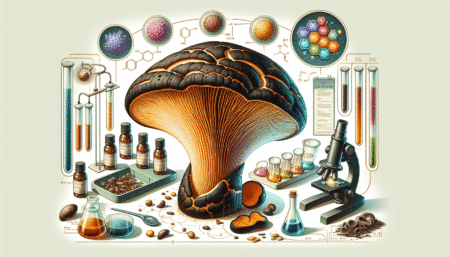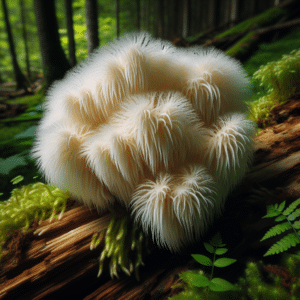- The importance of salvinorin A in various sage species
- Salvia divinorum: The best-known sage species with salvinorin A
- Salvia recognita: The Turkish rock sage
- Salvia glutinosa: The sticky sage
- The versatile application possibilities of Salvinorin A
- Salvinorin A as a potential drug: state of research and prospects
- The importance of salvinorin A for traditional healing methods
- The extraction of salvinorin A from various sage species
- The health benefits of salvinorin A for the human body
Would you like to learn more about the fascinating molecule salvinorin, which seems to come from another world? Salvinorin A, an agonist for opioid receptors, is the key to a variety of interesting articles and studies. On our website you can discover everything about the effects of salvinorin and its connection to sage, Salvia divinorum and other biomolecules. Dive into the world of salvinorins and find out how this unique substance transcends the boundaries of the ordinary!
1. the importance of salvinorin A in various sage species
Salvinorin A is a remarkable molecule found in various sage species that acts as an agonist at the κ-opioid receptors in the human body. This unique compound is crucial to the pharmacological properties of the sage species that contain it. Salvia divinorum in particular stands out as the best known species, which is rich in salvinorin A and has a strong psychoactive effect. However, this valuable biomolecule is also found in other species such as Salvia recognita and Salvia glutinosa. The versatile application possibilities of salvinorin A make it a fascinating object of research in the field of medicine and pharmacology. The extraction of this substance from the various sage species is a challenge, but holds great potential for the development of new medicines and therapies. Salvinorin A is therefore not only an interesting molecule, but also an important component of traditional healing methods with promising health benefits for the human body.
2. salvia divinorum: The best known sage species with salvinorin A
Salvia divinorum, the famous "magic mint", is one of the most fascinating types of sage with the coveted salvinorin A. This plant, which has been revered by indigenous cultures for centuries, has unique properties that set it apart from other sage species. Salvinorin A acts as a potent κ-opioid receptor agonist in the human body, giving Salvia divinorum its remarkable psychoactive effect. Researchers around the world are fascinated by this extraordinary substance and are investigating its many possible applications. Through targeted studies and experiments, they are trying to decipher the full potential of salvinorin A as a potential drug. Research into the sage species Salvia divinorum and its unique ingredient salvinorin A is an exciting focus of current biomolecular research and offers new insights into the pharmacological potential of this fascinating plant.
3. salvia recognita: the Turkish rock sage
Salvia recognita, also known as Turkish rock sage, is a fascinating sage species that contains the unique salvinorin A. This active ingredient is a potent κ-opioid receptor agonist and gives the plant its special properties. The use of Salvia recognita in traditional healing methods has a long history and continues to this day. The extraction of salvinorin A from this sage species is challenging, but the reward lies in the versatile applications that this active ingredient offers. Research into the health benefits of salvinorin A is promising and could open up new avenues in medicine. Salvia recognita is an important component of the sage species with salvinorin A and deserves to be further explored and appreciated.
4. salvia glutinosa: the sticky sage
Salvia glutinosa, also known as sticky sage, is characterized by its abundant occurrence of salvinorin A, a powerful agonistic agent. This unique ingredient makes this sage species particularly interesting for pharmaceutical research and potential medical applications. The sticky leaves and stems of Salvia glutinosa contain high concentrations of salvinorin A, making them a valuable biomole for the development of new drugs or therapeutic approaches. The interaction of salvinorin A with opioid receptors in the human body opens up a wide range of possibilities for the treatment of pain and other diseases. Researchers are therefore working intensively to further investigate the exact effect and potential of salvinorin A in Salvia glutinosa in order to optimize its medical applications.
5 The versatile application possibilities of Salvinorin A
Salvinorin A, a potent agonist at the κ-opioid receptors, has a wide range of potential applications. From the treatment of depression to the relief of neuropathic pain - the range of potential therapeutic applications is fascinating. Research in the field of biomolecules has shown that salvinorin A could also have promising effects in addiction disorders. The effect of this unique active ingredient in different sage species is a key aspect for the exploration of new drugs and therapies. The discovery of salvinorin A in Salvia divinorum has opened the door to numerous studies and developments that further explore the potential of this natural compound. The targeted search for new areas of application for salvinorin A could lead to the development of innovative treatment methods that could have a positive impact on the lives of many people.
6 Salvinorin A as a potential drug: state of research and perspectives
Salvinorin A shows interesting effects as an agonist at opioid receptors. Current studies are investigating its potential as a drug. Research is focusing on the diverse applications of this unique active ingredient. There is hope that salvinorin A could offer new treatment options for various diseases in the future. The prospects in the field of drug development are promising, as salvinorin A is seen as a promising candidate. New findings could enable groundbreaking advances in medicine. Research into the medical potential of salvinorin A is still in its infancy, but the results so far are promising and are arousing great interest in the scientific community. It remains exciting to see how developments in this area will continue.
7 The importance of salvinorin A for traditional healing methods
Salvinorin A plays an important role in traditional healing methods that have been used for centuries. The unique properties of this active ingredient, which is found in various types of sage, have attracted the interest of healers and shamans worldwide. Due to its ability to act as an agonist at opioid receptors, salvinorin A shows promising potential for alternative healing approaches. In combination with ritual practices, this active ingredient is used to induce deep states of consciousness and facilitate spiritual experiences. The close connection between Salvinorin A and traditional healing methods is reflected in the deep conviction that this natural substance possesses a special energetic power that contributes to the healing of body, mind and soul. Traditional practices use Salvinorin A as a powerful tool to strengthen the connection to nature and the higher levels of consciousness.
8. the extraction of salvinorin A from various sage species
The extraction of salvinorin A from different types of sage is a fascinating process that offers deep insights into the diversity of nature. The concentration of this unique active ingredient varies depending on the type and location of the sage, making extraction an artful science. Through careful selection and specialized techniques, researchers and experts are able to extract salvinorin A from plants such as Salvia divinorum, Salvia recognita and Salvia glutinosa. This challenging task requires precision and expertise to isolate the purest form of Salvinorin A. The use of modern methods such as chromatographic separation and precise analytical procedures is crucial to the success of this complex process. The extraction of salvinorin A from various sage species is of great importance for further research into the many possible applications of this fascinating natural substance.
9 The health benefits of salvinorin A for the human body
The health benefits of salvinorin A for the human body are remarkably diverse. As a potent κ-opioid receptor agonist, this compound shows a unique effect that is promising in the field of pain therapy. Research suggests that salvinorin A may also play a role in the treatment of addiction by influencing the activation of certain receptors. In addition, there is evidence that salvinorin A has neuroprotective properties and could potentially be used to prevent neurodegenerative diseases. The discovery of these versatile health benefits opens up new perspectives for the medical application of salvinorin A and shows the potential of this unique natural substance for the development of new therapies.
Further questions and answers about Salvinorin A
How effective is Salvinorin A?
Salvinorin A is a psychoactive substance that is mainly found in the plant Salvia divinorum. It is known for its strong hallucinogenic effects that occur after consumption. The potency of salvinorin A is mainly determined by its ability to bind to certain receptors in the brain, particularly the κ-opioid receptors. This binding leads to changes in the neuronal network and can cause intense changes in consciousness. Studies suggest that salvinorin A has potentially potent psychotropic effects, which can range from intense visual and auditory hallucinations to altered perceptions of space and time. It is thought that the substance could also be used for therapeutic purposes, particularly in the field of mental health. However, it is important to note that Salvinorin A should be used with caution due to its potent effects and potentially risky effects. Further research is needed to better understand the full potential and risks of this substance.
Who discovered Salvinorin A?
Salvinorin A was discovered by Alfredo Ortega and his colleagues at the University of Michigan in 1982. It is a highly psychoactive molecule found in the Mexican sage species Salvia divinorum. The researchers isolated salvinorin A from the leaves of this plant for the first time and identified it as the main active ingredient responsible for the hallucinogenic effect. The discovery of salvinorin A marked a significant step in the study of psychoactive compounds and their potential medical applications. Research into salvinorin A has provided new insights into the mechanisms of action in the brain and explored potential therapeutic applications. The discovery of salvinorin A has thus led to a deeper understanding of neuropharmacology and the effects of psychoactive substances.
References
- https://de.wikipedia.org/wiki/Salvinorin_A
- https://flexikon.doccheck.com/de/Salvinorin_A
- https://www.emcdda.europa.eu/publications/drug-profiles/salvia_de
YouTube
Note: The information in this article is for informational purposes only and is not intended to replace the advice of a physician or other healthcare professional. Always consult a doctor before using any new herbs or supplements. Furthermore, you should always check whether the cultivation/possession/use/processing of certain plants is permitted in your country. As we only offer ornamental plants in our store, we are only allowed to offer Provide information and advice on the correct care of plants!
















